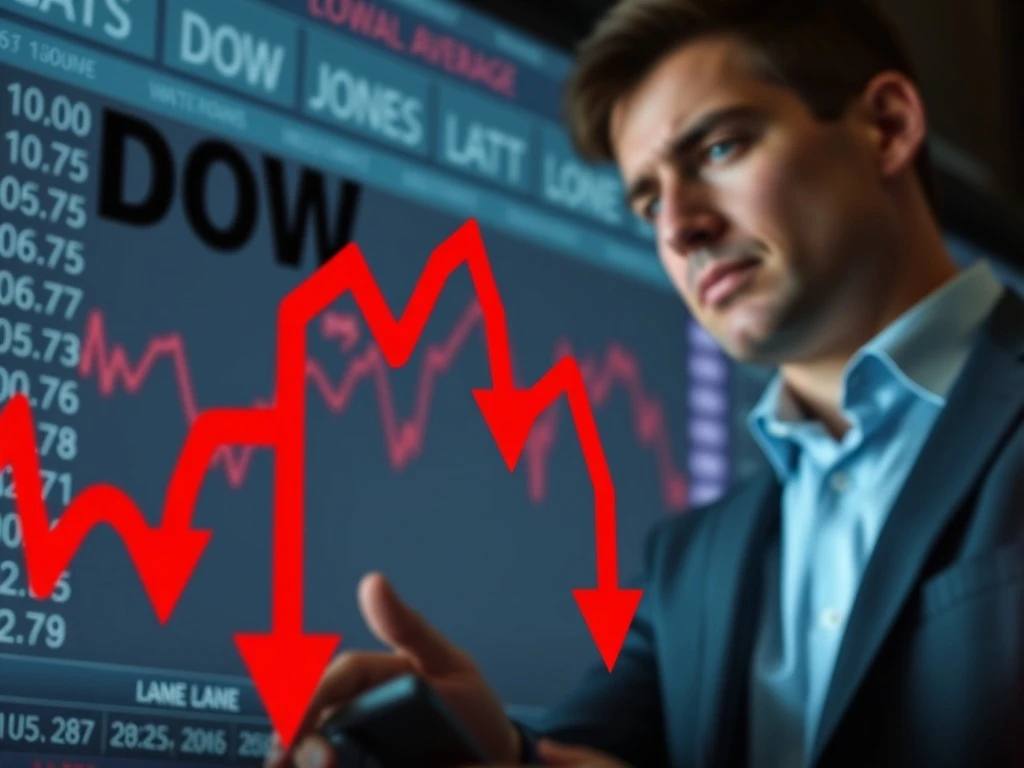The Dow Jones Industrial Average, a long-standing barometer of economic health, currently exhibits patterns suggesting underlying market unease. Investors and analysts alike are closely watching these **Dow Jones signals**. For business leaders and entrepreneurs, understanding these indicators is crucial. They can inform strategic planning and risk management. This analysis delves into what the Dow is indicating. It also explores how these signals might impact the broader financial landscape.
Understanding Dow Jones Signals
The Dow Jones Industrial Average (DJIA) represents 30 significant U.S. companies. It serves as a key indicator of stock market performance. While not as broad as other indices, its historical significance is undeniable. Many consider it a bellwether for the overall economy. Consequently, its movements are widely scrutinized. When the Dow displays unusual behavior, it often prompts questions. Are these **Dow Jones signals** merely noise? Or do they hint at deeper systemic issues?
Firstly, the Dow’s composition includes industrial giants. Therefore, its performance reflects the health of major sectors. Companies like Apple, Microsoft, and Goldman Sachs are part of this index. Their collective performance provides a snapshot of market sentiment. Secondly, analysts often look for divergences. For instance, if the Dow Industrials are rising but other key indices are falling, it raises concerns. This divergence can be a powerful signal. It suggests underlying weakness despite headline gains. Therefore, understanding the Dow requires looking beyond just its daily price movements.
Furthermore, the Dow’s long history provides context. It has weathered numerous economic cycles. Its past reactions to various economic conditions offer valuable insights. However, the market is dynamic. New factors constantly emerge. Therefore, interpreting current **Dow Jones signals** requires a nuanced approach. It involves combining historical data with present-day economic realities. This comprehensive view helps investors make informed decisions. It minimizes the risk of misinterpreting short-term fluctuations.
Key Indicators of Market Disruption: What Dow Jones Signals Reveal
Specific indicators within the Dow and related indices often provide early warnings. One prominent concept is Dow Theory. It posits that the market is in an upward trend if both the Dow Industrials and the Dow Transports reach new highs. Conversely, if one index fails to confirm the other, it signals potential trouble. For example, if the Dow Industrials are making new highs but the **Dow Jones Transportation Average** is lagging, it’s a significant warning. This divergence suggests that goods are not being transported as actively. This indicates slowing economic activity. It implies that the underlying economic engine might be sputtering.
Consider the following critical indicators:
- Dow Jones Transportation Average (DJTA) Divergence: This index includes airlines, railroads, and trucking companies. It often leads the industrial average. A decline in transports while industrials remain high can signal a slowdown. This is a classic **Dow Jones signal** of impending weakness.
- Utilities Sector Performance: The Utilities Sector is typically defensive. Investors flock to utilities during uncertain times. A strong performance in utilities, alongside weakness in growth sectors, suggests risk aversion. It indicates that investors are seeking safety.
- Volume Analysis: Declining trading volume on market rallies is a concern. Conversely, increasing volume on market declines indicates strong selling pressure. Low volume rallies suggest a lack of conviction among buyers. This can be a bearish **Dow Jones signal**.
- Market Breadth: This refers to the number of advancing stocks versus declining stocks. If the Dow is rising but fewer stocks are participating in the rally, it suggests a narrow market. This lack of breadth often precedes market corrections. It shows that only a few large companies are propping up the index.
These indicators, when viewed collectively, paint a clearer picture. They help identify potential market turning points. Understanding them allows investors to anticipate shifts. Consequently, they can adjust their portfolios proactively. This proactive approach is essential for managing risk effectively. It prepares one for potential market volatility. Thus, these specific **Dow Jones signals** become invaluable tools.
Historical Context: When Dow Jones Signals Were Right
History offers compelling examples where **Dow Jones signals** accurately foreshadowed significant market events. These instances underscore the index’s predictive power. However, past performance does not guarantee future results. Yet, examining these historical precedents provides valuable lessons. It highlights the importance of vigilance. It also demonstrates how market participants reacted to similar warnings.
One notable example occurred before the dot-com bubble burst in 2000. During that period, the Dow Industrials continued to climb. However, the Dow Transports showed signs of weakness. They failed to confirm the Industrials’ new highs. This divergence was a classic **Dow Jones signal**. It indicated that the underlying economic activity was not supporting the broader market’s exuberance. Subsequently, the tech bubble deflated. Many high-flying stocks experienced significant declines. This historical event serves as a stark reminder.
Similarly, before the 2008 financial crisis, certain **Dow Jones signals** were present. While not always a clear-cut divergence in the Dow Theory sense, other internal market indicators flashed red. For instance, the financial sector began showing cracks. Increased volatility and a flight to safety were observed. These subtle shifts, when combined with broader economic concerns, painted a cautious picture. The subsequent market downturn was severe. It impacted nearly every sector of the economy. These historical instances reinforce the idea that the Dow, while not infallible, often provides early warnings.
Therefore, paying attention to these signals is prudent. It allows for better risk assessment. It also encourages a more cautious approach to investing. While no single indicator is perfect, the Dow’s historical track record is compelling. It suggests that ignoring its warnings can be costly. Investors must learn from these past occurrences. They should integrate these lessons into their current market analysis. This historical perspective enriches understanding. It prepares one for potential future challenges. Consequently, recognizing these patterns becomes a vital skill for navigating market uncertainty.

Navigating Potential Market Shifts
When **Dow Jones signals** suggest market shifts, investors must consider proactive strategies. A cautious approach often proves beneficial during periods of uncertainty. Firstly, re-evaluating one’s portfolio allocation is wise. This involves assessing risk exposure. It also means considering defensive assets. These assets tend to perform better during economic downturns. For example, bonds, gold, and certain consumer staples stocks can offer stability. They help mitigate losses during volatile periods.
Secondly, diversification remains a cornerstone of sound investment. Spreading investments across various asset classes reduces risk. It prevents over-reliance on any single sector or security. Even if one part of the portfolio struggles, others may provide stability. This strategy is particularly important when **Dow Jones signals** hint at broad market weakness. It helps cushion the impact of potential declines. Furthermore, it ensures a balanced approach to long-term growth.
Thirdly, maintaining liquidity is crucial. Having access to cash allows investors to seize opportunities. It also provides a buffer during unexpected downturns. Avoiding excessive leverage is equally important. High debt levels can amplify losses during market corrections. Therefore, a conservative approach to borrowing is advisable. This financial prudence helps weather economic storms. It positions investors for recovery.
Finally, continuous education and independent research are vital. Do not rely solely on headline news or single indicators. Understand the underlying economic factors. Consult multiple reputable sources. This comprehensive understanding empowers investors. It enables them to make informed decisions. Consequently, they can navigate complex market environments more effectively. These strategies help investors respond thoughtfully to **Dow Jones signals**. They promote resilience in an ever-changing market landscape.
Expert Perspectives on Dow Jones Signals
Financial experts and analysts hold diverse views on current **Dow Jones signals**. Some interpret the recent patterns as typical market volatility. They suggest that corrections are healthy. These experts often point to strong corporate earnings or resilient consumer spending. They argue that underlying economic fundamentals remain sound. Therefore, they advise investors against overreacting to short-term fluctuations. They view these signals as part of the normal market cycle. This perspective emphasizes long-term growth prospects. It suggests that minor pullbacks offer buying opportunities.
However, other experts express greater caution. They highlight specific **Dow Jones signals** that warrant concern. These include persistent inflation, rising interest rates, or geopolitical tensions. They argue that these factors could lead to a more significant market correction. Some analysts point to specific divergences within the Dow Theory framework. They see these as clear warnings of potential economic contraction. These experts recommend a more defensive posture. They advise investors to reduce risk exposure. They also suggest increasing cash positions. This perspective emphasizes capital preservation during uncertain times.
Moreover, some market commentators focus on the behavioral aspects. They note the increasing reliance on algorithmic trading. This can amplify market movements. They also discuss the impact of retail investor sentiment. This can lead to rapid shifts in market dynamics. Consequently, understanding the human element is also crucial. It adds another layer to interpreting **Dow Jones signals**. These varying expert opinions underscore the complexity of market analysis. There is no single, universally accepted interpretation. Therefore, investors must weigh different viewpoints. They should form their own informed conclusions. This critical approach is essential for navigating the current economic climate.
In conclusion, the Dow Jones Industrial Average remains a vital gauge of market health. Its current patterns warrant careful attention. These **Dow Jones signals** are not definitive predictions. However, they provide valuable insights into potential shifts. Understanding these indicators empowers investors. It enables them to make informed decisions. Vigilance, diversification, and a long-term perspective are key. By staying informed, investors can better navigate the complexities of today’s financial markets. They can protect their investments. They can also position themselves for future opportunities. Always conduct thorough research before making any investment decisions.
Frequently Asked Questions (FAQs)
What is the Dow Jones Industrial Average (DJIA)?
The Dow Jones Industrial Average is a stock market index. It tracks the performance of 30 large, publicly-owned companies in the United States. It is one of the oldest and most widely recognized market indices. It serves as a barometer for the U.S. stock market and overall economic health.
How do Dow Jones Signals predict market trends?
Dow Jones Signals are derived from various observations. These include the index’s price action, volume, and divergences between the Industrial and Transportation Averages. According to Dow Theory, these signals can indicate potential market trend reversals. For example, if one average makes a new high but the other does not, it might signal a weakening trend.
What are key indicators to watch for in Dow Jones Signals?
Key indicators include divergences between the Dow Industrials and Transports. Additionally, watch for strong performance in defensive sectors like utilities. Pay attention to trading volume, especially declining volume on rallies. Also, monitor market breadth, which shows how many stocks are participating in a rally.
Should investors act solely on Dow Jones Signals?
No, investors should not act solely on Dow Jones Signals. While they offer valuable insights, they are just one set of indicators. A comprehensive investment strategy involves considering multiple factors. These include economic data, corporate earnings, geopolitical events, and individual risk tolerance. Always conduct thorough research and consider professional advice.
Are current Dow Jones Signals definitive for a market downturn?
Current Dow Jones Signals are not definitive proof of an impending market downturn. They indicate potential risks and warrant caution. Market conditions are complex and influenced by numerous variables. These signals serve as warnings. They prompt investors to reassess their portfolios and strategies. However, they do not guarantee specific outcomes.
























